 The Gotthard Rail Tunnels
The Gotthard Rail Tunnels
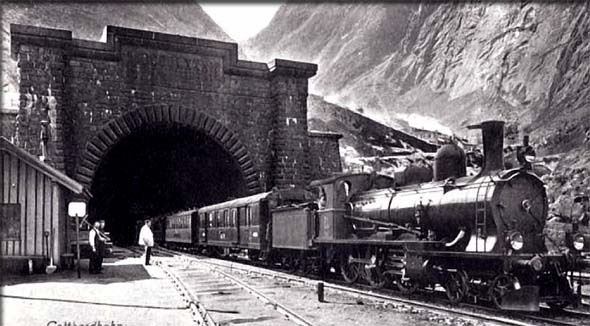
On June
1st, 2016, the longest rail tunnel in the world, the 35 ½ mile
Gotthard Base Tunnel was, opened. It was a technical achievement
that took 17 years to finish and unites northern and southern
Europe by allowing passage via high speed trains through some
of the most forbidding mountains in the world. What shouldn't
be forgotten in this success, however, is that another rail
tunnel, also the longest in the world at the time, was dug though
these same mountains almost a century and a half earlier. It
was an achievement that changed the face of commerce and travel
across 19th century Europe and a Wonder of the Age of Steam.
|
Seven
Quick Facts
|
| -Engineer
credited with designing the route: Robert Gerwig. |
| -Length
of the main tunnel: 9.3 miles (15km) - Longest in the
world at the time. |
| -Chief
Engineer of main tunnel: Louis Favre |
| -Number
of spiral approach tunnels: Five. |
| -Dates
of construction of main tunnel: 1872 to 1881. |
| -Number
of deaths during construction (estimated):177. |
| -Opening
date of the Gotthard Railway: May 22nd of 1882
|
The
Alps Mountains, running through the heart of Europe, had for
centuries been a barrier to easy travel from the northern side
of the continent to the southern regions. With the invention
of the steam locomotive in the early part of the 19th century,
railways quickly spread over much of Europe, but a short and
efficient connection through this section of the Alps was missing.
In 1850,
the Swiss government hired two of the most respected engineers
in the world, Robert Stephenson (whose father had invented the
steam locomotive) and H. Swinburne, to advise them on the best
method of making a railway connection through the Alps. The
pair proposed a route through the eastern Alps that would have
run from Lake Constantine to Ticino and then onto Milan. Rather
than a simple railway connection, however, the plan called for
a short, tunnel, high in the mountains, that would be reached
by a special, steep incline railway that used a cable or cog
system. This would have necessitated the transfer people and
goods several times between different types of trains to get
them over the mountains, making the route very inefficient.
Originally,
this course was supported by Alfred Escher, an influential Swiss
businessman in the area of banking and railroads. Escher had
been instrumental in pushing Switzerland to expand its rail
routes in late 1849 when he feared that rail development in
Europe would bypass his tiny Alpine country.
|
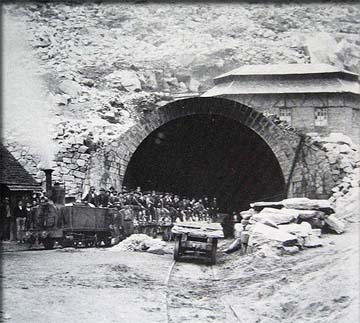
A
crew comes out of one of the tunnels riding a work train
in 1875.
|
The
eastern Alp line was never built and eventually Escher decided
that the Gotthard route was more promising. He threw all his
influence behind the project and by 1869 a decision was made
to start construction on the Gotthard railway. The next year
Escher helped found the Gotthard Railway Company which would
build and operate the line. The project, however, proved to
be an engineering challenge of the highest caliber.
The
Gotthard Pass
The
Saint-Gotthard Massif was the mountain range through which the
railroad would have to thread itself. With peaks as high as
10,500 feet (3,192 m), the best way through the range was the
Gotthard Pass. This pass through the mountains had been known
since ancient times, but was little used because of the difficulty
of crossing the turbulent Reuss River which intersected the
path. Crossing the Reuss was especially hard in the early summer
when it was swollen with snowmelt. With the construction of
a wooden bridge in around 1220, however, the trail was opened
for use with horses and pack mules.
With
a height of 6,909 feet (2,106 m), this original trail was too
difficult a climb for a normal railroad. It wasn't the height
so much, but the steepness of the path leading to the pass.
Normal railroad trains can only climb about 2 feet for every
100 feet of distance they travel. If a train tries to climb
a slope steeper than that, its wheels slip. Specialty railroads
can get around this by using cables or a cog gear that hold
the cars to a special part of the track, but this wasn't a solution
that would allow normal trains to travel the Gotthard pass.
Clever
Spiral Tunnels
|
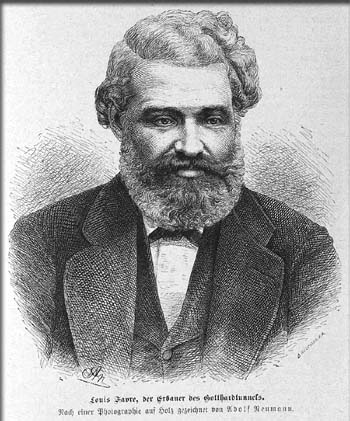
Louis
Favre
|
German
Engineer Robert Gerwig was charged with coming up with a route
through the mountains that would solve this problem. Gerwig's
solution required a 9.3 mile (15km) tunnel under the pass itself
along with five additional spiral tunnels on the approach to
the pass. These clever spiral tunnels would allow the trains
to gain height slowly by increasing the distance the train would
travel. The tracks would dive into a tunnel, then slowly climb
upwards on a large curve until the tracks emerged from the rock
at a higher altitude, but roughly the same location. This ingenious
arrangement allowed the train to gain height, while not making
the track itself too steep.
These
spiral tunnels, while shrewd engineering, were not unique to
the Gotthard line and had been used on the Brenner railway in
1867. The most difficult part of the project, instead, was the
long tunnel under the pass. A tunnel this long had never been
built before and would require a chief engineer of rare talent.
The man for the task turned out to be Swiss engineer, Louis
Favre.
Louis
Favre
Favre
was born in 1826, the son of a carpenter in a small village
just outside Geneva. He was not a well-schooled man, but acquired
his trade by observation and took night classes to learn whatever
else he needed.
On August
7th, 1872, Favre and his company won the contract to build the
main tunnel by underbidding 6 other companies. He promised it
would take only eight years and 56 million Swiss francs to complete
the job: one year and 12.5 million francs less than the next
lowest bid by his competition. This turned out to be a serious
miscalculation by Favre. While he would successfully complete
the tunnel and it would be considered his crowning achievement,
it would also lead to his financial ruin and ultimately his
death.
On September
18th, 1872, construction of the main tunnel commenced. Two crews
bored into the rock from each side, expecting to meet somewhere
about 4½ miles under the mountain. When they finally did, the
two tunnels they built were only 13 inches (33 cm) off from
each other horizontally and two inches off (5 cm) vertically.
For the 19th century, it was an amazing feat of engineering
by Favre and his crew.
|
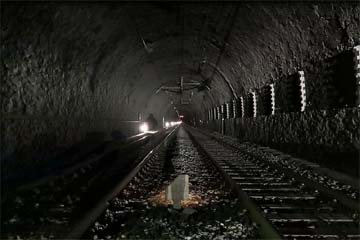
Inside the
tunnel today. (Photo by Kecko. Licensed
under the Creative Commons Attribution 2.0 Generic license)
|
On earlier
projects, black powder had been used as an explosive to excavate
such tunnels. Later nitroglycerin (sometimes called "blasting
oil") was employed. While nitro was more powerful than black
powder, making the work go faster, it also was very unstable
and difficult to handle. Dropping it could initiate a blast
at the wrong time, killing dozens of workers. The Gotthard project
was the first tunnel to use the newly-invented product dynamite
instead. Dynamite had the power of nitro but was in a solid
form that included substances that made it less prone to be
set off by a shock, making the work of excavating with explosives
much safer.
Even
with using the newly-invented dynamite, however, the job was
a herculean effort, slowed by both technical and geological
glitches. On several occasions, large amounts of water broke
into the tunnel, causing the roof to collapse on the construction
crews. It is estimated that a total of 177 people were killed
before the completion of the project.
It is
little wonder that between low wages and high danger, Favre
found himself faced with discontent from his employees. During
1875, a strike by Italian tunnel workers was brutally suppressed
by the Swiss Army. Four people died and 13 other were wounded
in the incident.
Legal
disputes with his lender bank and the construction subdivision
of the Gotthard Railway Company further delayed the effort.
Eventually the tunnel was completed 10 months late. This was
a financial disaster for Favre as the contract he had agreed
upon fined him 5,000 francs for each day he went over schedule
for the first 6 months and 10,000 francs for each day after
that. Favre's company was driven into bankruptcy. Even worse,
however, Favre himself died four months prior to the completion
of the excavation.
Favre's
Death
On July
19, 1879, Favre and two others took an inspection tour of the
tunnel. Chief engineer in charge of that section of the tunnnel,
M. E. Stockalper, was with him, along with a visiting French
engineer. Stockalper had observed over the past few months that
the pressure of running the difficult and financially-failing
project seemed to be making Favre age prematurely and was concerned
about him. As an account of that day written by general secretary
of the company, Maxime Helene explained:
|
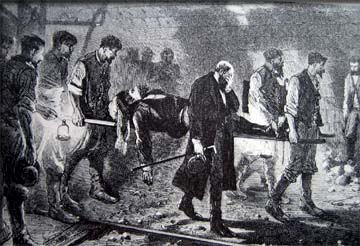
Favre's
body is carried from the tunnel.
|
"Up
to the end of the inspection he had complained of nothing, but,
according to his habit, went along examining the timbers, stopping
at different points to give instructions, and making now and
then a sally at his friend, who was unused to the smell of dynamite.
In returning he began to complain of internal pains. "My dear
Stockalper," said he, "take my lamp, I will join you." At the
end of ten minutes not seeing him return, M. Stockalper exclaimed,
"Well! M. Favre, are you coming?" No answer. The visitor and
engineer retraced their steps, and when they reached Favre he
was leaning against the rocks with his head resting upon his
breast. His heart had already ceased to beat. A train loaded
with excavated rock was passing and on this was laid the already
stiff body of him who had struggled up to his last breath to
execute a work all science and labor."
The
railway itself opened on May 22nd of 1882 and it the way changed
travel was done in Europe. Before the line initiated operations,
it is estimated an average of 80,000 people and 40,000 tons
of material passed through the Gotthard pass per year using
an old road. In the years following the opening of the railroad,
those figures jumped to 250,000 people and 300,000 tons. By
1908, the figures had further increased to 750,000 passengers
and 900,000 tons of goods.
So Favre's
tunnel and the railway it supported went on to be an unqualified
success.
On February
29th of 1880, when a small opening was made between the two
tunnel excavations working north and south to meet under the
mountain, a tin canister was pushed through the tiny gap first.
The canister bore the image of Favre, so that despite his death,
he came to be the first person to pass through the tunnel. Written
in French on the back of the can were the words: "Who else would
deserve to be first to go through? He was our champion, friend
and father. Long live the Gotthard!"
|
A
map of part of the route, showing two of the spiral tunnels.

|

Copyright
Lee Krystek 2016. All Rights Reserved.